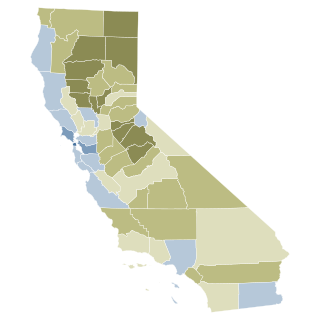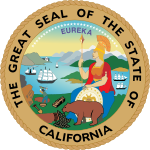
Proposition 13 is an amendment of the Constitution of California enacted during 1978, by means of the initiative process. The initiative was approved by California voters on June 6, 1978. It was upheld as constitutional by the United States Supreme Court in the case of Nordlinger v. Hahn, 505 U.S. 1 (1992). Proposition 13 is embodied in Article XIII A of the Constitution of the State of California.

In California, a ballot proposition is a referendum or an initiative measure that is submitted to the electorate for a direct decision or direct vote. If passed, it can alter one or more of the articles of the Constitution of California, one or more of the 29 California Codes, or another law in the California Statutes by clarifying current or adding statute(s) or removing current statute(s).

California Proposition 81 was a ballot initiative on the ballot for California voters in the primary election of June 6, 2006. As SB 1161, it passed through the Senate 28-9 and the Assembly 57–15. On the ballot, it did not pass, having received 1,873,147 (47%) votes in favor and 2,110,132 (53%) votes against.

Proposition 218 is an adopted initiative constitutional amendment which revolutionized local and regional government finance and taxation in California. Named the "Right to Vote on Taxes Act," it was sponsored by the Howard Jarvis Taxpayers Association as a constitutional follow-up to the landmark property tax reduction initiative constitutional amendment, Proposition 13, approved in June 1978. Proposition 218 was approved and adopted by California voters during the November 5, 1996, statewide general election.

The 2007 Texas constitutional amendment election took place 6 November 2007.

California Proposition 92 was Californian ballot proposition that voters rejected on February 5, 2008. It was a state initiative that would have amended Proposition 98, which set a mandate for the minimum level of funding each year for elementary and secondary schools and for the California Community Colleges.

California's state elections were held on November 5, 2002. Necessary primary elections were held on March 5. Up for election were all the seats of the California State Assembly, 20 seats of the California Senate, seven constitutional officers, all the seats of the California Board of Equalization, as well as votes on retention of two Supreme Court justices and various appeals court judges. Seven ballot measures were also up for approval. Municipal offices were also included in the election.

Proposition 3 is a law that was enacted by California voters by means of the initiative process. It is a bond issue that authorizes $980 million in bonds, to be repaid from state's General Fund, to fund the construction, expansion, remodeling, renovation, furnishing and equipping of children's hospitals. The annual payment on the debt authorized by the initiative is approximately $64 million a year. Altogether, the measure would cost about $1.9 billion over 30 years out of California's general fund.

California Proposition 10, also known as the California Alternative Fuels Initiative, was an unsuccessful initiated state statute that appeared on the November 2008 ballot in California. Proposition 10 was funded by Clean Energy Fuels Corp., a corporation owned by T. Boone Pickens. Clean Energy Fuels Corp. is the nation's leading operator of natural gas vehicle fueling stations.

Proposition 12 appeared on the November 4, 2008 ballot in California. It is also known as the Veterans' Bond Act of 2008. The measure was legislatively referred to the ballot in Senate Bill 1572. The primary sponsor of SB 1572 was Senator Mark Wyland, R-Carlsbad. The vote to place the measure on the ballot was passed unanimously in both the California state senate (39-0) and assembly (75-0).

Proposition 39 was an initiative state constitutional amendment and statute which appeared on the November 7, 2000, California general election ballot. Proposition 39 passed with 5,431,152 Yes votes, representing 53.4 percent of the total votes cast. Proposition 39 was essentially a milder version of Proposition 26, which would have ended the Proposition 13 supermajority vote requirement altogether, but was defeated with 3,521,327 "Yes" votes, representing 48.7 percent of the total votes cast, in the March 7, 2000, California primary election. The measure was funded by Ann and John Doerr, John T. Walton and Reed Hastings; it was opposed by the Howard Jarvis Taxpayers Association.

In California state elections, 2014 was the first year in which the top statewide offices were elected under the nonpartisan blanket primary, pursuant to Proposition 14, which passed with 53% voter approval in June 2010. Under this system, which first went into effect during the 2012 election year, all candidates appear on the same ballot, regardless of party. In the primary, voters may vote for any candidate, regardless of their party affiliation. The top two finishers, regardless of party, then advance to face each other in the general election in November.

Proposition 218 is an adopted initiative constitutional amendment in the state of California that appeared on the November 5, 1996, statewide election ballot. Proposition 218 revolutionized local and regional government finance in California. Called the “Right to Vote on Taxes Act,” Proposition 218 was sponsored by the Howard Jarvis Taxpayers Association as a constitutional follow-up to the landmark Proposition 13 property tax revolt initiative constitutional amendment approved by California voters on June 6, 1978. Proposition 218 was drafted by constitutional attorneys Jonathan Coupal and Jack Cohen.

Proposition 51 is a California ballot proposition that passed on the November 8, 2016 ballot, regarding $9 billion in bonds to fund construction and improvement of K-12 and community college facilities. The measure designates $7 billion for K-12 projects falling under four types of projects, and $2 billion for any facility project for community colleges. No other bond measures related to education have been on the California ballot since 2006.

The California state elections in 2020 were held on Tuesday, November 3, 2020. Unlike previous election cycles, the primary elections were held on Super Tuesday, March 3, 2020.

California state elections in 2018 were held on Tuesday, November 6, 2018, with the primary elections being held on June 5, 2018. Voters elected one member to the United States Senate, 53 members to the United States House of Representatives, all eight state constitutional offices, all four members to the Board of Equalization, 20 members to the California State Senate, and all 80 members to the California State Assembly, among other elected offices.

California Proposition 68 was a legislatively referred constitutional amendment that appeared on ballots in California in the June primary election in 2018. It was a $4.1bn bond measure to fund parks, environmental projects, water infrastructure projects and flood protection measures throughout California.

California Proposition 15 was a failed citizen-initiated proposition on the November 3, 2020, ballot. It would have provided $6.5 billion to $11.5 billion in new funding for public schools, community colleges, and local government services by creating a "split roll" system that increased taxes on large commercial properties by assessing them at market value, without changing property taxes for small business owners or residential properties for homeowners or renters. The measure failed by a small margin of about four percentage points.

California Proposition 14 is a citizen-initiated ballot measure that appeared on the ballot in the 2020 California elections, for November 3, 2020. It authorizes state bonds to be issued worth $5.5 billion, which will fund the California Institute for Regenerative Medicine (CIRM), which serves as the state's center for stem cell research, and enable it to continue its operations. This measure passed with 51% of the vote.






